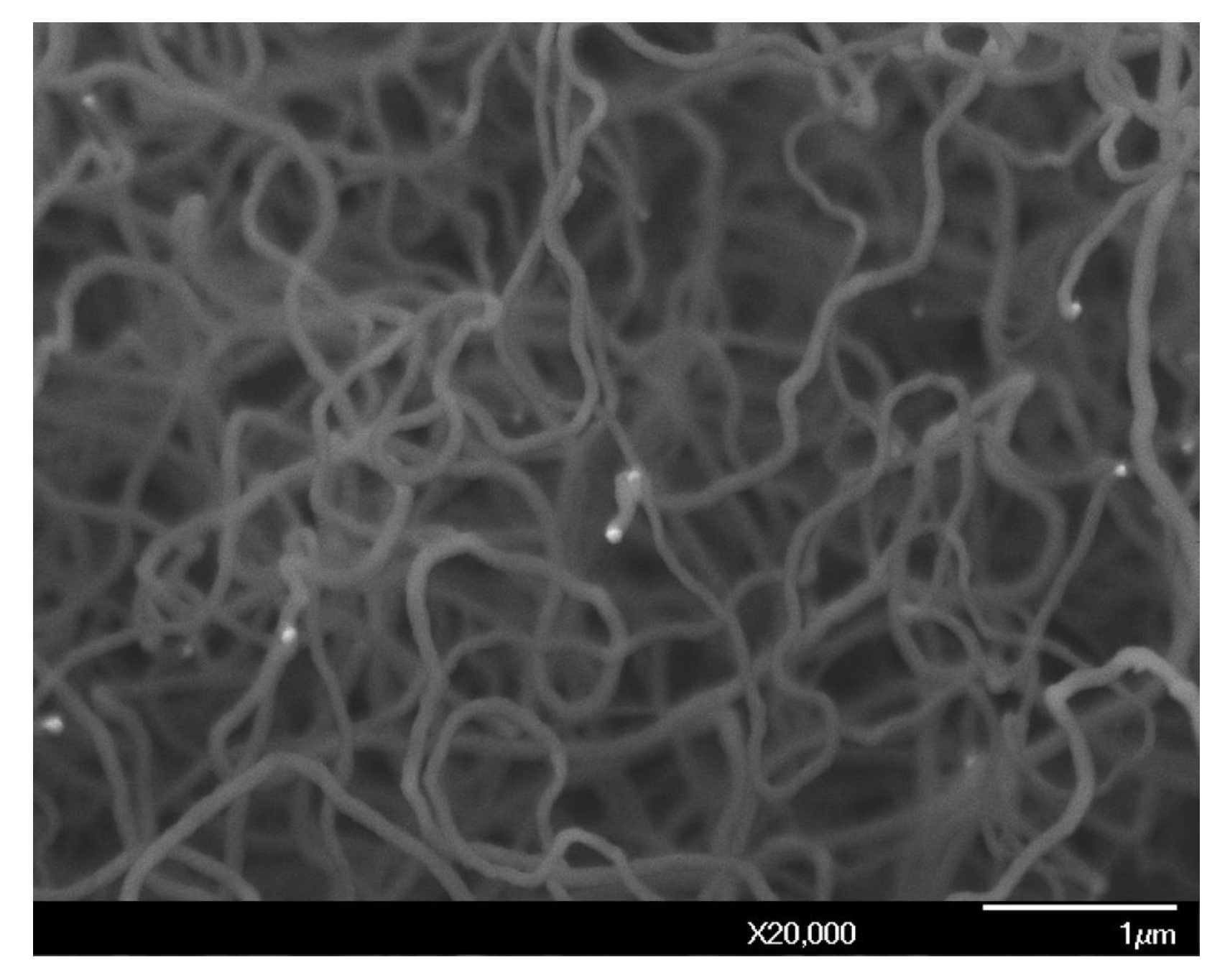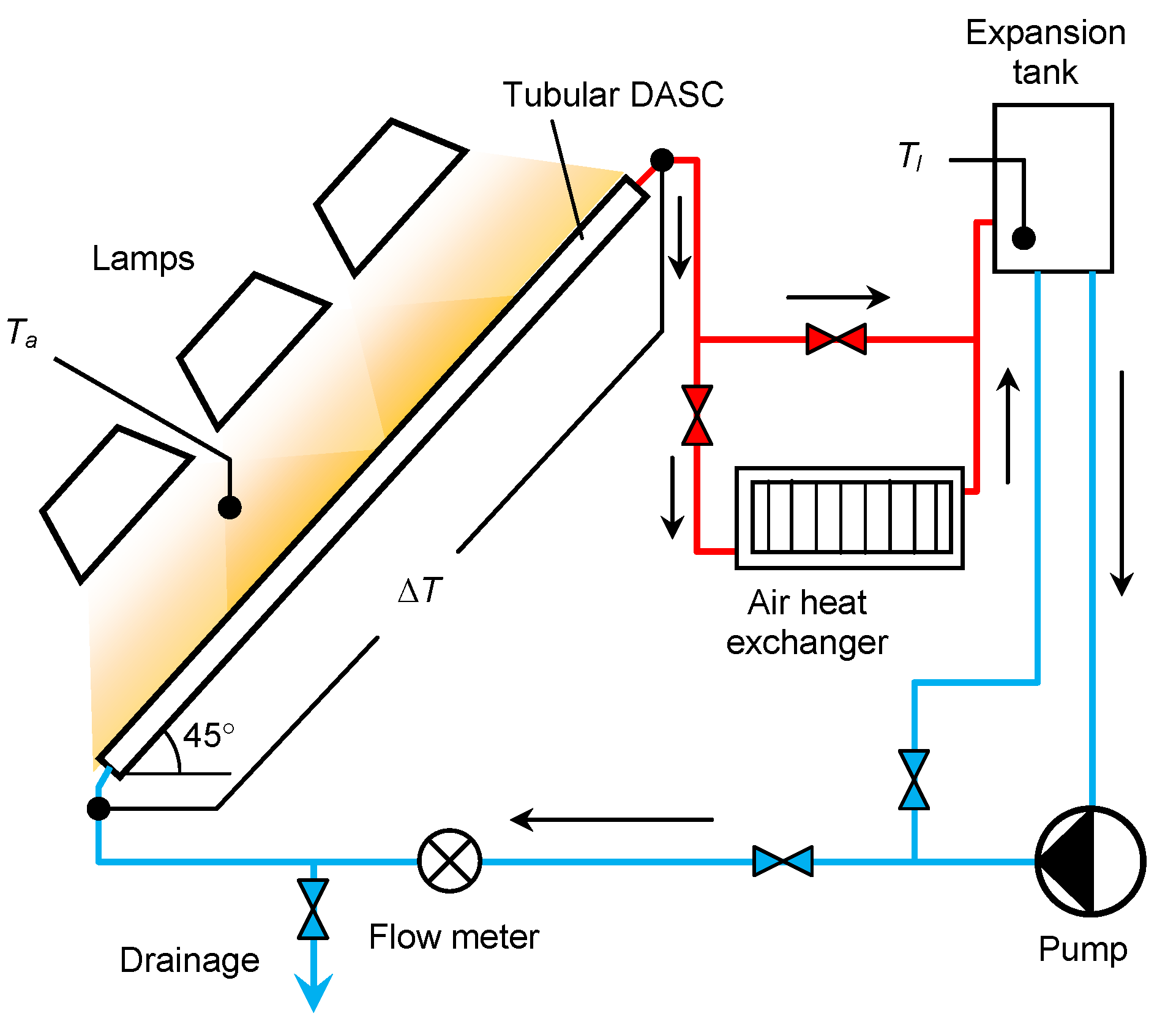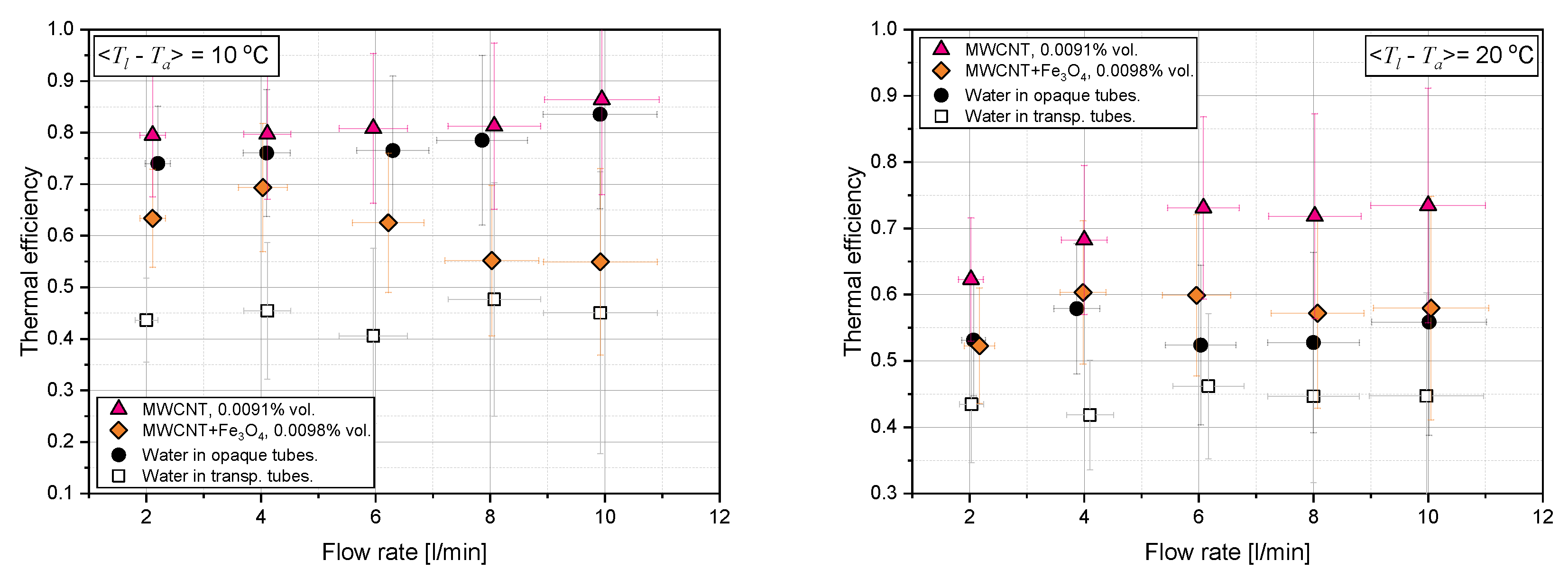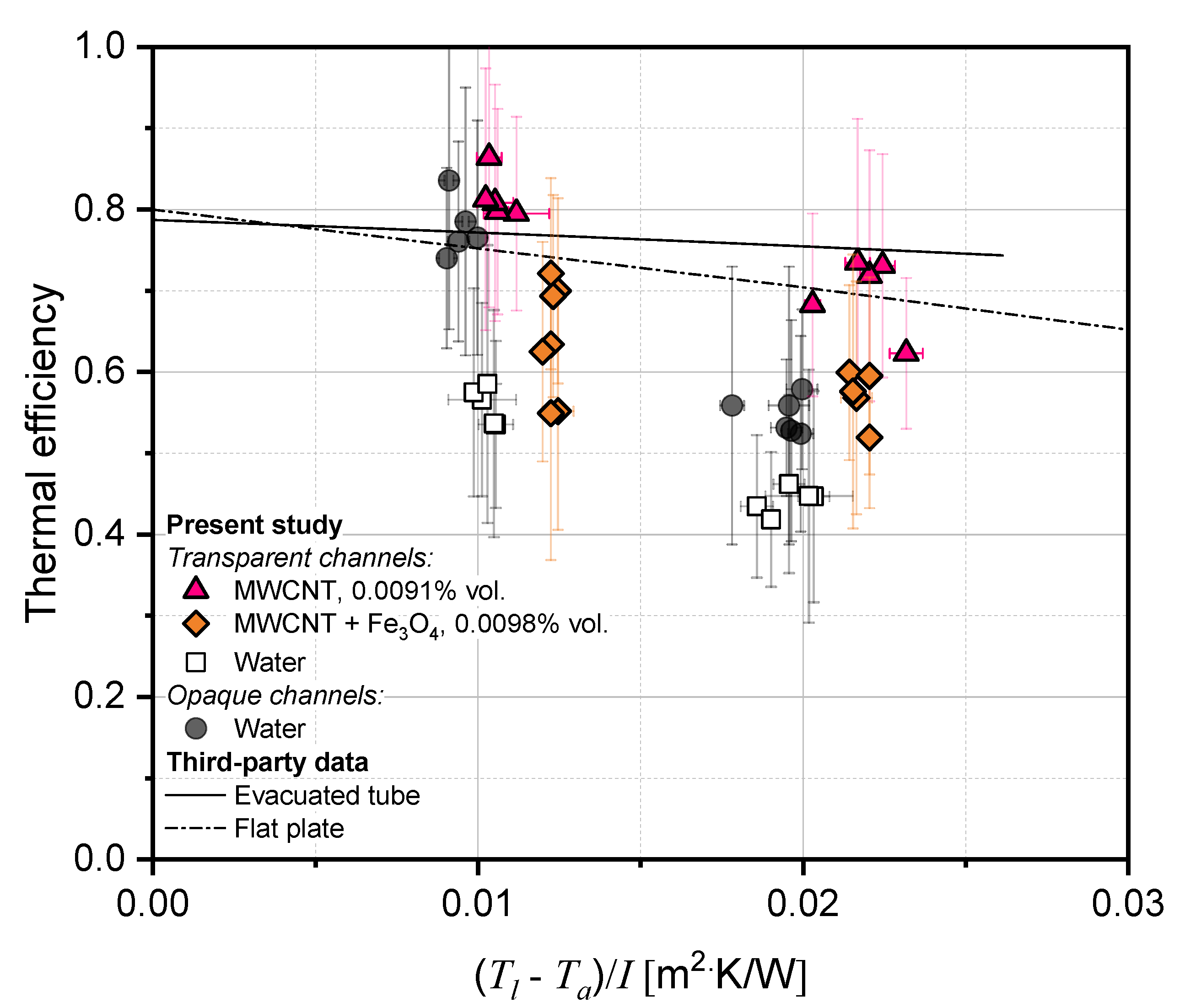Hybrid Nanofluid in a Direct Absorption Solar Collector: Magnetite vs. Carbon Nanotubes Compete for Thermal Performance
Abstract
:1. Introduction
2. Experiments
2.1. Nanofluid
2.2. Experimental Set-Up
3. Results and Discussion
4. Conclusions
Author Contributions
Funding
Institutional Review Board Statement
Informed Consent Statement
Data Availability Statement
Acknowledgments
Conflicts of Interest
References
- Choi, S.S.; Eastman, A. Enhancing thermal conductivity of fluids with nanoparticles. Dev. Appl. Non-Newton. Flows 1995, 231, 99–105. [Google Scholar]
- Boldoo, T.; Ham, J.; Cho, H. Comprehensive Experimental Study on the Thermophysical Characteristics of DI Water Based Co0.5Zn0.5Fe2O4 Nanofluid for Solar Thermal Harvesting. Energies 2020, 13, 6218. [Google Scholar] [CrossRef]
- Kristiawan, B.; Rifa’i, A.I.; Enoki, K.; Wijayanta, A.T.; Miyazaki, T. Enhancing the thermal performance of TiO2/water nanofluids flowing in a helical microfin tube. Powder Technol. 2020, 376, 254–262. [Google Scholar] [CrossRef]
- Purnama, B.; Rahmawati, R.; Wijayanta, A.T.; Suharyana, S. Dependence of Structural and Magnetic Properties on Annealing Times in Co-precipitated Cobalt Ferrite Nanoparticles. J. Magn. 2020, 20, 207–210. [Google Scholar] [CrossRef] [Green Version]
- Arshad, A.; Jabbal, M.; Yan, Y.; Reay, D. A review on graphene based nanofluids: Preparation, characterization and applications. J. Mol. Liq. 2019, 279, 444–484. [Google Scholar] [CrossRef]
- Alam, T.; Balam, N.; Kulkarni, K.; Siddiqui, M.; Kapoor, N.; Meena, C.; Kumar, A.; Cozzolino, R. Performance Augmentation of the Flat Plate Solar Thermal Collector: A Review. Energies 2021, 14, 6203. [Google Scholar] [CrossRef]
- Raj, P.; Subudhi, S. A review of studies using nanofluids in flat-plate and direct absorption solar collectors. Renew. Sustain. Energy Rev. 2018, 84, 54–74. [Google Scholar] [CrossRef]
- Qu, J.; Zhang, R.; Wang, Z.; Wang, Q. Photo-thermal conversion properties of hybrid CuO-MWCNT/H2O nanofluids for direct solar thermal energy harvest. Appl. Therm. Eng. 2019, 147, 390–398. [Google Scholar] [CrossRef]
- Li, X.; Zeng, G.; Lei, X. The stability, optical properties and solar-thermal conversion performance of SiC-MWCNTs hybrid nanofluids for the direct absorption solar collector (DASC) application. Sol. Energy Mater. Sol. Cells 2020, 206, 110323. [Google Scholar] [CrossRef]
- Alsaady, M.; Fu, R.; Yan, Y.; Liu, Z.; Wu, S.; Boukhanouf, R. An experimental investigation on the effect of ferrofluids on the efficiency of novel parabolic trough solar collector under laminar flow conditions. Heat Transf. Eng. 2019, 40, 753–761. [Google Scholar] [CrossRef]
- Hu, G.; Ning, X.; Hussain, M.; Sajjad, U.; Sultan, M.; Muhammad Ali, H.; Shah, T.R.; Ahmad, H. Potential evaluation of hybrid nanofluids for solar thermal energy harvesting: A review of recent advances. Sustain. Energy Technol. Assess. 2021, 48, 101651. [Google Scholar] [CrossRef]
- Mashhadian, A.; Heyhat, M.M.; Mahian, O. Improving environmental performance of a direct absorption parabolic trough collector by using hybrid nanofluids. Energy Convers. Manag. 2021, 244, 114450. [Google Scholar] [CrossRef]
- Menbari, A.; Alemrajabi, A.A.; Rezaei, A. Experimental investigation of thermal performance for direct absorption solar parabolic trough collector (DASPTC) based on binary nanofluids. Exp. Therm. Fluid Sci. 2017, 80, 218–227. [Google Scholar] [CrossRef]
- Karami, M. Experimental investigation of first and second laws in a direct absorption solar collector using hybrid Fe3O4/SiO2 nanofluid. J. Therm. Anal. Calorim. 2019, 136, 661–671. [Google Scholar] [CrossRef]
- Department of Geophysics, U.O.B. Været i Bergen (The Weather in Bergen). 2022. Available online: https://veret.gfi.uib.no/?action=period_query (accessed on 7 February 2022).
- Popsueva, V.; Lopez, A.F.O.; Kosinska, A.; Nikolaev, O.; Balakin, B.V. Field Study on the Thermal Performance of Vacuum Tube Solar Collectors in the Climate Conditions of Western Norway. Energies 2021, 14, 2745. [Google Scholar] [CrossRef]
- Struchalin, P.; Yunin, V.; Kutsenko, K.; Nikolaev, O.; Vologzhannikova, A.; Shevelyova, M.; Gorbacheva, O.; Balakin, B. Performance of a tubular direct absorption solar collector with a carbon-based nanofluid. Int. J. Heat Mass Transf. 2021, 179, 121717. [Google Scholar] [CrossRef]
- National Institute of Standards and Technology. NIST Chemistry WebBook. Water. Available online: https://webbook.nist.gov/cgi/cbook.cgi?Name=water&Units=SI (accessed on 29 January 2021).
- Stabnikov, V.N.; Royter, I.M.; Protsuk, T.B. Ethanol; Food Industry: Moscow, Russia, 1976. (In Russian) [Google Scholar]
- Engineering ToolBox. Ethanol—Density and Specific Weight. 2018. Available online: https://www.engineeringtoolbox.com/ethanol-ethyl-alcohol-density-specific-weight-temperature-pressure-d_2028.html (accessed on 29 January 2021).
- Marcos, M.A.; Podolsky, N.E.; Cabaleiro, D.; Lugo, L.; Zakharov, A.O.; Postnov, V.N.; Charykov, N.A.; Ageev, S.V.; Semenov, K.N. MWCNT in PEG-400 nanofluids for thermal applications: A chemical, physical and thermal approach. J. Mol. Liq. 2019, 294, 111616. [Google Scholar] [CrossRef]
- Wan, M.; Yadav, R.R.; Mishra, G.; Singh, D.; Joshi, B. Temperature dependent heat transfer performance of multi-walled carbon nanotube based aqueous nanofluids at very low particle loadings. Johns. Matthey Technol. Rev. 2015, 59, 199–206. [Google Scholar] [CrossRef]
- Tong, Y.; Boldoo, T.; Ham, J.; Cho, H. Improvement of photo-thermal energy conversion performance of MWCNT/Fe3O4 hybrid nanofluid compared to Fe3O4 nanofluid. Energy 2020, 196, 117086. [Google Scholar] [CrossRef]
- Rohsenow, W.M.; Hartnett, J.P.; Cho, Y.I. Handbook of Heat Transfer; McGraw-Hill: New York, NY, USA, 1998; Volume 3. [Google Scholar]
- NPOMASH. Flat-Plate Solar Collector SOKOL-EFFECT. Available online: http://www.sokolnpo.ru/ (accessed on 14 December 2020).
- Viessmann Manufacturing Company. Vacuum Tube Solar Collector “Vitosol 200-T SP2A”. Available online: https://www.viessmann-us.com/en/residential/solar/tube-collectors/vitosol_200-t_sp2a.html (accessed on 14 December 2020).
- Sharaf, O.Z.; Al-Khateeb, A.N.; Kyritsis, D.C.; Abu-Nada, E. Four-way coupling of particle-wall and colloidal particle-particle interactions in direct absorption solar collectors. Energy Convers. Manag. 2019, 195, 7–20. [Google Scholar] [CrossRef]





| Parameter | Range of the Values |
|---|---|
| Flow rate [L/min] | 2 …4 …6 …8 … 10 |
| Re | 2166 …4333 …6500 …8667 … 10,834 |
| Nu | 4.5 …31.7 …61.8 …78.1 … 93.9 |
| Pressure drop [kPa] | 0.4 …0.9 …1.7 …2.6 … 4.0 |
Publisher’s Note: MDPI stays neutral with regard to jurisdictional claims in published maps and institutional affiliations. |
© 2022 by the authors. Licensee MDPI, Basel, Switzerland. This article is an open access article distributed under the terms and conditions of the Creative Commons Attribution (CC BY) license (https://creativecommons.org/licenses/by/4.0/).
Share and Cite
Struchalin, P.G.; Kuzmenkov, D.M.; Yunin, V.S.; Wang, X.; He, Y.; Balakin, B.V. Hybrid Nanofluid in a Direct Absorption Solar Collector: Magnetite vs. Carbon Nanotubes Compete for Thermal Performance. Energies 2022, 15, 1604. https://doi.org/10.3390/en15051604
Struchalin PG, Kuzmenkov DM, Yunin VS, Wang X, He Y, Balakin BV. Hybrid Nanofluid in a Direct Absorption Solar Collector: Magnetite vs. Carbon Nanotubes Compete for Thermal Performance. Energies. 2022; 15(5):1604. https://doi.org/10.3390/en15051604
Chicago/Turabian StyleStruchalin, Pavel G., Dmitrii M. Kuzmenkov, Vladimir S. Yunin, Xinzhi Wang, Yurong He, and Boris V. Balakin. 2022. "Hybrid Nanofluid in a Direct Absorption Solar Collector: Magnetite vs. Carbon Nanotubes Compete for Thermal Performance" Energies 15, no. 5: 1604. https://doi.org/10.3390/en15051604
APA StyleStruchalin, P. G., Kuzmenkov, D. M., Yunin, V. S., Wang, X., He, Y., & Balakin, B. V. (2022). Hybrid Nanofluid in a Direct Absorption Solar Collector: Magnetite vs. Carbon Nanotubes Compete for Thermal Performance. Energies, 15(5), 1604. https://doi.org/10.3390/en15051604






